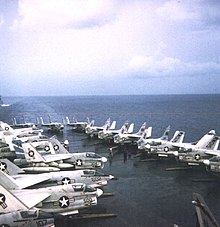USS Ticonderoga (CV-14)
Following those tests, she conducted air operations – day and night landing and antiaircraft defense drills – until 18 October, when she exited Pearl Harbor and headed for the western Pacific.
Early on the morning of 11 November, her aircraft combined with others of TF 38 to attack a Japanese reinforcement convoy, just as it was preparing to enter Ormoc Bay from the Camotes Sea.
Though the storm cost Admiral William Halsey's force three destroyers and over 800 lives, Ticonderoga and the other carriers managed to ride it out with a minimum of damage.
The carriers did not return to sea until 30 December 1944 when they steamed north to hit Formosa and Luzon in preparation for the landings on the latter island at Lingayen Gulf.
After a fueling rendezvous on 8 January, Ticonderoga sped north at night to get into position to blanket Japanese airfields in the Ryūkyūs during the Lingayen assault the following morning.
Ticonderoga provided combat air patrol coverage on 11 January and helped to bring down four enemy aircraft which attempted to snoop the formation.
[3] The stricken carrier arrived at Ulithi on 24 January but remained there only long enough to move her wounded to hospital ship Samaritan, to transfer her air group to Hancock, and to embark passengers bound for home.
On 2–3 June, Ticonderoga fighters struck at airfields on Kyūshū in an effort to neutralize the remnants of Japanese air power – particularly the kamikaze – and to relieve the pressure on American forces at Okinawa.
During those raids, TF 38 aircraft found the sad remnants of the once-mighty Japanese Fleet and bagged battleships Ise, Hyūga, and Haruna as well as an escort carrier, Kaiyō, and two heavy cruisers.
After a stop in Pearl Harbor in November to alter the carrier to accommodate additional passengers for the Operation Magic Carpet voyage, she steamed to Okinawa, Japan, to pick up servicemen and returned home with a Typhoon on her back reaching Alameda Navy Yard in Oakland, CA in December 1945.
Leaving Philippines in early January 1946, she headed home to Puget Sound Naval Shipyard outside of Seattle, WA delivering an estimated two to four thousand returning servicemen and unloading armaments and ammunition before entering the Bremerton Navy Yard to prepare for inactivation.
During the ensuing 29 months, the carrier received numerous modifications – steam catapults to launch jets, a new nylon barricade, a new deck-edge elevator and the latest electronic and fire control equipment – necessary for her to become an integral unit of the fleet.
On 2 August 1956, Ticonderoga returned to Norfolk and entered the shipyard to receive an angled flight deck and an enclosed hurricane bow as part of the SCB-125 program.
On 2 August, while operating in international waters in the Gulf of Tonkin, the destroyer Maddox reported being attacked by units of the (North) Vietnam People's Navy.
President Lyndon Johnson responded with a reprisal to what he felt at the time to be two unprovoked attacks on American seapower and ordered retaliatory air strikes on selected North Vietnamese motor torpedo boat bases.
The USN attacks reportedly resulted in the destruction of 25 PT-type boats, severe damage to the bases, and almost complete razing of the oil storage depot.
[3] After a return visit to Japan in September, the aircraft carrier resumed normal operations in the South China Sea until winding up the deployment late in the year.
[6] No public mention was made of the incident at the time and it would not come to light until a 1981 United States Department of Defense report revealed that a one-megaton bomb had been lost.
Nearly coincidental with the Tet Offensive, the siege of Khe Sanh began and Pueblo, an American spy ship, was seized by the North Koreans and taken to Wonsan harbor.
[citation needed] Between January 1968 and July 1968, Ticonderoga was on the line off the coast of Vietnam for five separate periods totaling 120 days of combat duty.
During that time, her air wing flew just over 13,000 combat sorties against North Vietnamese and Viet Cong forces, most frequently in the continuing attempts to interdict the enemy lines of supply.
Shortly thereafter, Ticonderoga moved to the Long Beach Naval Shipyard for repairs and certain conversions to handle the A-7 Corsair attack jet and to prepare for her fifth combat cruise in February 1969.
The aircraft carrier took station off Vietnam for her last line period of the deployment on 26 June and there followed 37 more days of highly successful air sorties against enemy targets.
Ticonderoga concluded the deployment—a highly successful one, for she received her third Navy Unit Commendation for her operations during that tour of duty—when she left Subic Bay on 4 September.
After almost a month of post-deployment stand-down, she moved to the Long Beach Naval Shipyard in mid-October to begin conversion to an antisubmarine warfare (ASW) aircraft carrier.
which was being filmed in 1970, Ticonderoga Flight Deck Number 14 briefly appears in shot, while playing Admiral William (Bull) Halsey's Flagship USS Enterprise (CV-6).
The first of these two cruises also brought operations in the Indian Ocean with units of the Thai Navy and a transit of Sunda Strait during which a ceremony was held to commemorate the loss of the cruisers Houston and HMAS Perth in 1942.
In between these two last deployments, she operated in the eastern Pacific and participated in the recovery of the Apollo 16 Moon mission capsule and astronauts 215 miles SE off Christmas Island during April 1972.
The film chronicles the life of Miyabe Kyuzo, a highly skilled and conscientious pilot serving in the Imperial Japanese Navy during World War II.
The inclusion of the USS Ticonderoga in The Eternal Zero underscores the carrier's historical significance during the Pacific War and highlights its enduring legacy in popular culture.







